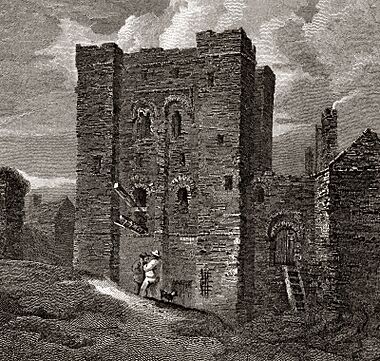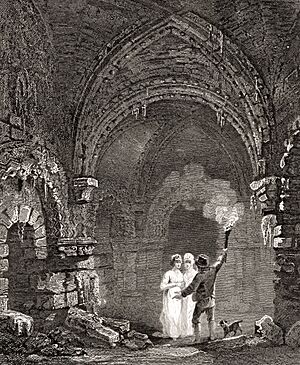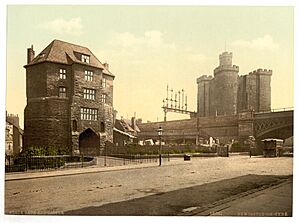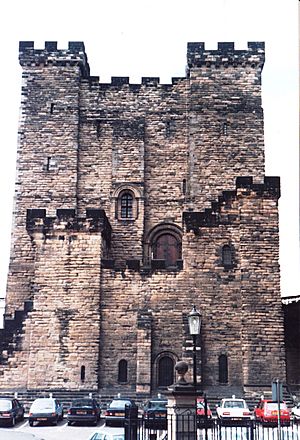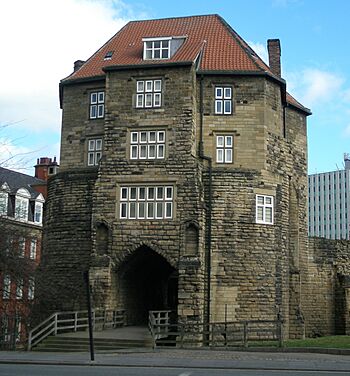The Castle, Newcastle facts for kids
Quick facts for kids The Castle, Newcastle |
|
|---|---|
| Newcastle upon Tyne | |
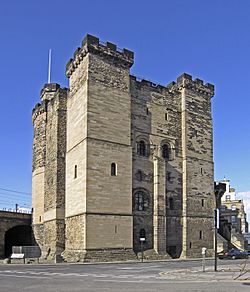
Newcastle Castle Keep, with a
railway viaduct behind at left |
|
|
Shown within Tyne and Wear
|
|
| Coordinates | 54°58′08″N 1°36′38″W / 54.9688°N 1.6105°W |
| Type | Norman |
| Site history | |
| Built | 1177 |
| Built by | Henry II |
Newcastle Castle is an amazing medieval fortification in Newcastle upon Tyne, England. It's built on the very spot where the city got its name! The most important parts you can still see today are the Castle Keep (the main stone tower) and the Black Gate (a strong gatehouse).
This spot has been used for defense since Roman times. Back then, it had a fort and a settlement called Pons Aelius. This name meant 'bridge of Aelius' and referred to the Roman emperor Hadrian. The fort guarded a bridge over the River Tyne.
In 1080, Robert Curthose, the oldest son of William the Conqueror, built a wooden castle here. It was a "motte-and-bailey" style castle. This 'New Castle upon Tyne' was built after he returned from a fight against Malcolm III of Scotland.
Later, King Henry II built the strong stone Castle Keep between 1172 and 1177. This was on the same spot as Robert Curthose's wooden castle. Then, King Henry III added the Black Gate between 1247 and 1250.
Today, you won't see any parts of the Roman fort or the first wooden castle above ground. The Keep is a very important Grade I listed building and a scheduled monument. This means it's protected because of its history.
The Castle Keep and Black Gate were built before the Newcastle town wall. The town wall started being built around 1265 and didn't include the castle. The Keep is right in the middle of Newcastle, near Newcastle station. A railway viaduct, which carries the East Coast Main Line to Scotland, now fills most of the space between the Keep and the Black Gate.
Today, the Keep and Black Gate are managed by the Old Newcastle Project. They are combined into one exciting place called "Newcastle Castle" for visitors to explore.
Contents
A Look Back: Roman Times
Around the mid-2nd century, the Romans built the first bridge across the River Tyne where Newcastle is now. They called it Pons Aelius, named after Emperor Hadrian. Hadrian was the one who started building Hadrian's Wall.
The Romans also built a fort to protect this important river crossing. This fort was on a rocky hill overlooking the new bridge. Hadrian's Wall ran just north of this Roman fort. It's thought that the Wall went down (or up) a street called the Side, which is just north of the Black Gate.
Later, in the Anglo-Saxon age, the area became known as Monkchester. This name suggests there might have been a monastery there, but we don't know exactly where. In the late 600s, a cemetery was started on the site of the old Roman fort.
The First Castle: A Wooden Wonder
In 1080, King William I (William the Conqueror) sent his son, Robert Curthose, north to protect the kingdom from the Scots. After his mission, Robert Curthose came to Monkchester and started building a 'New Castle'.
This first castle was a "motte-and-bailey" type. Imagine a wooden tower on top of a big earth mound (the motte). This was surrounded by a ditch (moat) and a wooden fence (the bailey).
In 1095, Robert de Mowbray, the Earl of Northumbria, rebelled against William Rufus. King Rufus sent an army to stop the revolt and capture the castle. After that, the castle belonged to the king. It became a key place for the king to control the powerful lords in the north.
Building a Strong Stone Castle
Today, there's no sign of the wooden tower or mound from the first motte-and-bailey castle. King Henry II decided to replace it with a strong, rectangular stone keep. Work on this began in 1168 and it was built between 1172 and 1177.
A stone outer wall, shaped like a triangle, replaced the earlier wooden one. The main builder, Maurice, also worked on Dover Castle. The impressive outer gateway, known as 'the Black Gate', was added later. It was built between 1247 and 1250, during the time of King Henry III.
Later in the 1200s, stone walls with towers were built around the town for extra protection. These town walls made the castle less important for defense. By 1589, during the reign of Queen Elizabeth I, the castle was described as being in ruins. From the early 1600s, things got worse as shops and houses were built on much of the castle site.
Castle in a Time of War
In 1643, during the English Civil War, the Royalist Mayor of Newcastle, Sir John Marley, fixed up the Keep. He probably also made the castle stronger again. In 1644, the Scottish army came to help the Parliamentarians. They surrounded Newcastle for three months.
The town walls were badly damaged. The last soldiers to give up on October 19, 1644, did so from inside the Castle Keep.
From the 1500s to the 1700s, the Keep was used as a prison. By 1800, many houses had been built inside the castle's old boundaries.
The Castle in the 1800s
In 1809, the Newcastle Corporation bought the Keep. They put on a new roof and added battlements (the notched walls on top). Also, the private homes within the castle grounds were torn down. The Keep was repaired in 1810, 1812, and 1848.
In the mid-1800s, the railway came to Newcastle. A huge viaduct (a long bridge) was built north of the Keep, crossing the castle site. Because of this, only the Keep and the Black Gate remain today.
Modern Times: The Castle Today
The Keep was restored again between the 1960s and 1980s. During this time, crumbling outside stonework was replaced and the inside was cleaned.
The Black Gate: A Grand Entrance
The "Black Gate" was added to Newcastle Castle between 1247 and 1250. It was an extra strong entrance, called a barbican, in front of the castle's earlier north gate. It had two towers with a passage running between them. On each side of the passage was a guardroom with an arched ceiling.
There was a drawbridge at the front (facing west) and another at the back. There was also a portcullis, a heavy gate that could be lowered to block the entrance.
The original Black Gate probably had a flat roof. But in 1618, King James I rented the gatehouse to a courtier named Alexander Stephenson. Stephenson changed the gatehouse a lot, rebuilding the upper floors. He then rented it out to different people, including a merchant named Patrick Black. It was Patrick Black who gave the Black Gate its name!
Over time, houses were built along both sides of the passageway. One part of the building even became a pub. By the early 1800s, the Black Gate had become a crowded tenement building, housing up to sixty people.
The Black Gate was rented to the Society of Antiquaries of Newcastle upon Tyne in the 1880s. They restored it greatly between 1883 and 1885. The Society added the top floor and the sloped roof you see today. They had a museum and held meetings there for many years. The Bagpipe Museum that was once there moved to Morpeth Chantry Bagpipe Museum in 1987. Wooden footbridges have replaced the old drawbridges at the front and back of the Black Gate.
Visiting Newcastle Castle Today
The Keep is a Grade I listed building and a scheduled monument, meaning it's very important historically. It's a roughly square building, about 19 meters by 17 meters and 25 meters tall. The entrance leads up stairs to the second floor and into the Great Hall. This is the biggest room in the Keep, about 9 meters by 7 meters.
The Black Gate used to be reached by a drawbridge over a moat. Now, a wooden bridge is there instead. The original gate had a portcullis, and you can still see the spaces where it fit. The Keep is owned by Newcastle City Council and managed by the Heart of the City Partnership.
You can visit Newcastle Castle today! It's quite unique because the main East Coast railway line runs right through its grounds. From the castle's battlements, you get amazing views over the River Tyne quayside, Newcastle Cathedral, and Newcastle station. Some people say the castle is haunted, and it has been featured on TV shows about ghosts.
The Castle Keep and the Black Gate were recently updated by the Heart of the City partnership. They reopened on March 21, 2015, as Newcastle Castle. Now, there's an external lift for easier access to the Black Gate. New additions include an education center, a gift shop, a museum room in the Black Gate, and cool audio-visual displays in the Castle Keep. These displays tell the story of the site and the people who lived there over hundreds of years.
See also
 In Spanish: Castillo de Newcastle para niños
In Spanish: Castillo de Newcastle para niños



